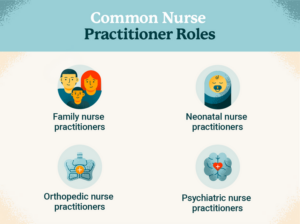M2 Discussion Compare the primary care NP role with other APN roles
 Primary Care NP Role vs. Other APN Roles
Primary Care NP Role vs. Other APN Roles
M2 Discussion: Compare the primary care NP role with other APN roles.
What are the similarities among the roles, what are the differences between NPs and APNs, and how would you communicate the role to a healthcare provider and a consumer?
Introduction
Primary care Nurse Practitioners (NPs) and Advanced Practice Nurses (APNs) play pivotal roles in patient care, contributing to enhanced and improved patient outcomes. While these roles share fundamental importance, it is crucial to recognize both their similarities and differences. Practitioners, as well as stakeholders like consumers and healthcare providers, benefit from a comprehensive understanding of these roles.

Struggling to meet your deadline?
Get your assignment on Compare the primary care NP role with other APN roles done by certified MDs and PhDs in the USA. ORDER NOW!
Both primary care NPs and APNs are licensed registered nurses possessing substantial abilities and knowledge, demonstrating clinical competencies, and adhering to jurisdiction-specific standards (Schober, 2018). APNs, further distinguished by having a master’s or doctorate degree, undergo specialized training and pass national certification exams in areas such as CNM (Certified Nurse Midwife), CNS (Clinical Nurse Specialist), CRNA (Certified Registered Nurse Anesthetist), or NP (Nurse Practitioner). Advancement in any of these roles necessitates the demonstration of family-centered and patient-centered care practices, along with proficiency in advanced pharmacology, pathophysiology, and health assessment. While a CNS role may not mandate a pediatric clinical rotation, a primary NP is required to have such experience.
Similarities and Differences
Despite their distinctions, these roles share several similarities. A notable commonality is their focus on delivering patient-centered care within the healthcare environment. Additionally, their practices are guided by the education, training, and certifications they have acquired, subject to rules and regulations in different jurisdictions. This implies that the scope of practice may vary, encountering restrictions and limitations depending on the state. Ethical decision-making, education, consultation, collaboration, leadership, evidence-based practice, and direct clinical practice are integral components characterizing both roles (Kristofersson et al., 2022).
Effectively communicating the roles of Advanced Practice Nurses (APNs), particularly Clinical Nurse Specialists (CNS), and Primary Care Nurse Practitioners (NPs), is crucial, especially in scenarios like the collaboration in diabetes care. When patients have inquiries regarding medications and lifestyle adjustments for optimal diabetes management, the primary physician may recommend consultation with a diabetic CNS (Wilson et al., 2019). This collaborative approach results in the formulation of patient-focused care, demonstrating the integral role of the APN in the healthcare team.
In situations where patients seek comprehensive guidance and support for diabetes care, the specialized knowledge and skills of a diabetic CNS can be instrumental. The CNS, working in tandem with the primary physician, provides valuable insights into medication regimens and suggests lifestyle modifications tailored to the patient’s specific needs. This collaborative effort ensures that patients receive well-rounded care that addresses both medical and lifestyle aspects of diabetes management.
By involving a diabetic CNS in the care process, the patient gains a clearer understanding of the roles and contributions of different healthcare professionals. The collaborative approach emphasizes patient education, ensuring that individuals are well-informed about their condition and actively engaged in decision-making regarding their healthcare. This not only enhances patient comprehension but also fosters a sense of empowerment and partnership in the management of chronic conditions like diabetes. In essence, the communication of NP roles becomes more tangible and patient-centric through these collaborative initiatives.
Effective Communication
An APN is a registered nurse who has completed a graduate degree (master’s or doctorate) from an accredited school and, after program completion, passed a national certification exam to specialize in a particular area (NP, CRNA, CNS, or CNM). All APN programs prioritize patient- and family-centered care and typically include standard courses such as advanced health assessment, advanced pathophysiology, and advanced pharmacology before specializing in one of the four roles. For instance, an NP program may incorporate a pediatric clinical practice rotation, while a CNS program might not necessitate such an experience. All APN programs mandate a minimum number of clinical hours for graduation.
Commonalities across all APN roles encompass direct clinical practice, evidence-based practice, leadership, collaboration, consultation, education, and ethical decision-making (Hamric, 2013). The scope of practice for all APNs includes assessment, diagnosis, and autonomy in practice. However, the extent of autonomy may vary among states, with some permitting APNs to practice independently.
Differences between APN roles revolve around population specialization, including neonatal, women’s health, adult health, community health, or psychiatric health. Specialized practices such as diabetes, oncology, wound care, and transplant also distinguish APN roles.
The primary care NP role, established in the 1960s, focuses on primary care and differs from other APN roles due to its emphasis on comprehensive patient care. A primary care NP is trained to promote health, assess, diagnose, interpret diagnostic tests, and treat diseases holistically (Pohl & Kao, 2013) (Taylor et al., 2021).
Conclusion
In conclusion, primary care NPs constitute the largest number among APN roles (AANP, 2021). While APN roles share core competencies and values, distinctions exist in their scopes of practice. Despite variations in specialties, all healthcare providers, including NPs, should adopt a patient-centered care approach. Understanding the roles of nurse practitioners, the advanced practice nursing differences, and how to communicate NP roles to patients is essential for effective healthcare delivery.
References
Kristofersson, G. K., Higgins, A., & Kilkku, N. (2022). Role and Competencies of Advanced Practice Mental Health Nurses. In Advanced Practice in Mental Health Nursing: A European Perspective (pp. 19-42). Cham: Springer International Publishing. Doi: 10.1007/978-3-031-05536-2_2
Schober, M. (2018). Global emergence of nurse practitioner/advanced practice nursing roles. Journal of the American Association of Nurse Practitioners, 30(4), 182–184. Doi: 10.1097/JXX.0000000000000029
Wilson, M., Chen, H. S., & Wood, M. (2019). Impact of nurse champion on quality of care and outcomes in type 2 diabetes patients. JBI Evidence Implementation, 17(1), 3-13. Doi: 10.1097/XEB.0000000000000156
American Association of Nurse Practitioners (AANP). (2020, March 3). More Than 290,000 Nurse Practitioners Licensed in the United States. https://www.aanp.org/news-feed/290-000-nps-licensed-in-us.
American Association of Nurse Practitioners (AANP). (2021, May). NP fact sheet. https://www.aanp.org/about/all-about-nps/np-fact-s…
Cockerham, A. Z., & Keeling, A. W. (2013). A Brief History of Advanced Practice Nursing in the United States. In A. B Hamric, C. M. Hanson, M. F. Tracy, & E. T. O’Grady (Eds.), Advanced Practice Nursing: An integrative approach (5th ed., pp. 01-26). Elsevier. ISBN: 978-1-4557-3980-6.
Hamric, A. B. (2013). A definition of Advanced Practice Nursing. In A. B Hamric, C. M. Hanson, M. F. Tracy, & E. T. O’Grady (Eds.), Advanced Practice Nursing: An integrative approach (5th ed., pp. 67-85). Elsevier. ISBN: 978-1-4557-3980-6.
Pohl, J. M., & Kao, T. S. A. (2013). The Primary Care Nurse Practitioner. In A. B Hamric, C. M. Hanson, M. F. Tracy, & E. T. O’Grady (Eds.), Advanced Practice Nursing: An integrative approach (5th ed., pp. 396-428). Elsevier. ISBN: 978-1-4557.
Nurse Practitioners (NPs) and Advanced Practice Nurses (APNs) both serve as registered nurses, drawing on a substantial knowledge base and skill set to provide clinical care guided by jurisdiction-specific guidelines. The dynamic landscape of healthcare has led to an evolution in the roles of NPs and APNs. This discussion aims to delve into the similarities and differences between these professionals and explore effective communication strategies to convey their roles to both healthcare practitioners and consumers.
Beginning with their similarities, NPs and APNs are versatile professionals, offering their services in a range of settings, including clinics, hospitals, long-term care facilities, and outpatient centers. As highlighted by Schober et al. (2020), they often function as physician extenders, performing tasks such as diagnosis, prescription of treatment and medication, and, depending on state laws, admission of patients. Both NPs and APNs are required to hold a master’s degree as an entry-level practice, engaging in continuing education programs to expand their clinical competencies, enabling them to function effectively as physician extenders.
Despite these similarities, significant differences exist between NPs and APNs. APNs can specialize in distinct roles such as nurse anesthetists, midwives, or clinical nurse specialists (CNS). Staff Writers (2021) highlight that nurse anesthetists require certification from the National Board of Certification & Recertification for Nurse Anesthetists (NBCRNA), while nurse-midwives receive accreditation from the American Midwifery Certification Board (AMCB) (Staff Writers, 2021). In contrast, NPs typically serve as primary care providers, offering their services independently without the need for specialization certifications. They play a vital role in delivering diverse healthcare services to various populations in primary care settings.
Effectively communicating the roles of NPs and APNs to healthcare providers and consumers necessitates emphasizing their areas of practice. For healthcare providers and consumers to grasp the distinctions, it is crucial to convey that APNs specialize in specific areas, such as women’s healthcare and surgical settings, as nurse anesthetists. Meanwhile, NPs operate as primary healthcare professionals, providing a broad spectrum of healthcare services without the need for specialization certifications. Clearly delineating the scope of practice for these professionals helps healthcare providers and consumers understand the subtle differences in their roles.
In conclusion, the roles of NPs and APNs in healthcare settings are indispensable, addressing the unique needs of patients. While APNs engage in specialty practices, influencing evidence-based nursing and holistic care within defined fields, NPs contribute to various healthcare fields, offering comprehensive care to diverse patient populations. Both play pivotal roles in transforming the quality of care in healthcare settings.
References
Schober, M., Lehwaldt, D., Rogers, M., Steinke, M., Turale, S., Pulcini, J., … & Stewart, D. (2020). International Council of Nurses Guidelines on advanced Practice Nursing 2020. International Council of Nurses. https://www.icn.ch/system/files/documents/2020-04/ICN_APN%20Report_EN_WEB.pdf

Dont wait until the last minute.
Provide your requirements and let our native nursing writers deliver your assignments ASAP.



